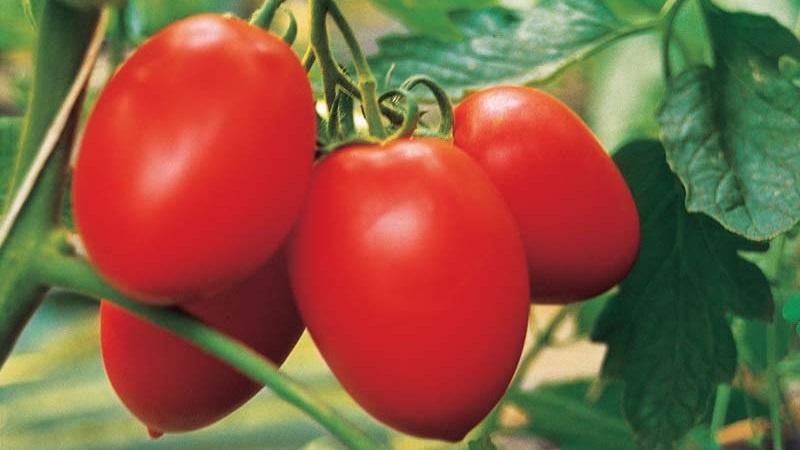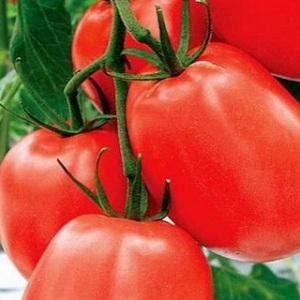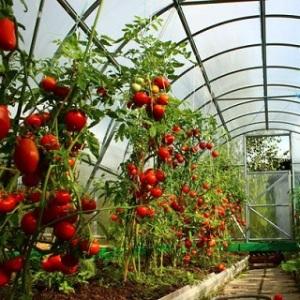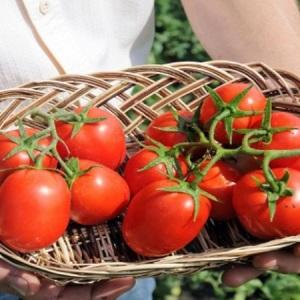High-yielding and unpretentious Benito tomato - the secrets of getting a rich harvest
Benito's tomato is the result of a successful crossing of several varieties. It is appreciated for its excellent taste, good yield, and unpretentious care. The variety will certainly appeal to lovers of classic tomatoes.
The content of the article
Characteristics and description of the variety
Benito F1 variety bred by Dutch breeders... This is a hybrid of the first generation, which means that the plants are as viable as possible and have the best set of genetic characteristics.

Distinctive features
The plant is determinant, the height of the bushes is 50-70 cm... The amount of foliage is moderate. The leaves themselves are large, drooping, dark green. Each bush has 5-7 clusters with fruits. 7-9 tomatoes ripen on the brush.
According to the speed of ripening, these tomatoes are classified as medium early... The first harvest is obtained 95-113 days after germination.
Grown both in greenhouses and in the open field.
Fruit characteristics
The fruits have an elongated plum shape.... The sizes are average. The weight of tomatoes is 40-70 g, but sometimes they grow up to 100 g. When ripe, tomatoes acquire a bright red color.
The skin is firm. The pulp is firm, with few seeds, deep red color. The variety is appreciated for the excellent taste of the fruit.
Benito is a fertile variety with high yields: up to 8 kg of fruits are harvested from one bush.
It will be interesting:
Tomato "Eldorado" and features of its cultivation
How to grow seedlings
Seeds for seedlings are sown in early March... Some preparatory work is required before landing.
Seed preparation
Before planting, it is recommended to disinfect the seeds by keeping them for 15-20 minutes in a 1% solution of potassium permanganate or in aloe juice. Then the seeds are washed with running water. These actions will help get rid of pathogens that live on the surface of the seeds. Purchased material does not have to be decontaminated.
Council. If you want to increase yields, treat the seedling material with a specialized solution to stimulate seed growth.
Capacity and soil
 The soil used for seedlings should be light, nutritious and rich in minerals. If you are planning to buy soil for seedlings, then choose peat.
The soil used for seedlings should be light, nutritious and rich in minerals. If you are planning to buy soil for seedlings, then choose peat.
If you prepare the soil yourself, then mix peat, humus and river sand in the ratio 60:30:10. Add 1 cup wood ash. The soil should be disinfected from pathogens. To do this, bake it in the oven.
The optimal capacity is the seedling boxes... In them, it is convenient to care for all the sprouts at the same time and easily move the containers to the right place.
Sowing
Seeds are planted in grooves 2 cm at a distance of 2 cm from each other... The soil is pre-heated to a temperature of 22 degrees.
Then the soil with seeds is watered with warm, settled water and cover the box with foil or thin glass. This is necessary to ensure the correct level of moisture and early germination of seeds.
Place containers in a well-lit room with a temperature of +25 degrees.
Growing and care
After the first shoots appear, the film is removed... Take care of good lighting.If there is no room with natural light, use lamps. The seedlings are kept under the light every day - at least 12 hours. Organize micro-ventilation at night, but avoid drafts.
When a pair of full-fledged leaves forms on the seedlings, the plants must be dived into separate pots. So the sprouts will not interfere with each other and the root system will develop in full force. When transplanting, feed with liquid food.
After picking, the seedlings are watered regularly from a watering can or using a spray bottle, but as the soil dries up. Avoid stagnant moisture, this will harm the seedlings.
Important! Warm water is sprayed over the soil, preventing it from getting on the stems and leaves of plants.
Seedlings need to be fertilized twice with an interval of 2 weeks.
So that the seedlings grow strong and adapt well when transplanting, 2 weeks before planting, they begin to harden it. Take the seedling boxes outside for several hours daily, gradually increasing the time the seedlings stay outdoors.
How to grow tomatoes
There is no particular specifics in growing Benito tomatoes... Follow the basic guidelines for growing nightshades.
Landing
First of all, you should take care of the preparation of the soil.... Indeed, in many respects the taste and quantity of the future harvest depends on its quality.
The soil needs to be loosened and organic fertilizers added (manure, straw, compost). If the soil is acidic, add lime to the soil.
Reference. In the fall, dig up the areas where you plan to plant tomatoes, and add humus to the soil.
 Seedlings are planted in greenhouses in the second half of May, and in open ground - closer to the beginning of June. It is important that the earth warms up and there is no frost at night. By this time, the bushes have reached a height of about 30 cm. Each plant will have 6-7 full leaves.
Seedlings are planted in greenhouses in the second half of May, and in open ground - closer to the beginning of June. It is important that the earth warms up and there is no frost at night. By this time, the bushes have reached a height of about 30 cm. Each plant will have 6-7 full leaves.
Before planting the bushes, the soil is watered and thoroughly loosened... The holes are prepared by placing fertilizer with phosphorus at the bottom. The distance between the shoots should be 50 cm. It is best to organize the planting in a checkerboard pattern.
The sprouts are transferred to the holes along with a clod of earth from the pots.... Then the soil around the bushes is compacted and watered abundantly.
It is better to tie the plants directly to the support at the top..
Read also:
Plant care
Before the formation of inflorescences, the plants are watered once a week, but abundantly... During flowering, the bushes need more moisture, so watering is organized more often - once every 4 days. During fruiting and ripening of fruits, excessive moisture, on the contrary, will negatively affect the quality of tomatoes. Therefore, the frequency of watering is reduced to 1 time per week. Better to use warm, settled water. Watering should be done early in the morning or in the evening, when there is no direct sunlight.
Weed as needed. After weeding, the soil around the bushes is carefully loosened so as not to damage the root system of the plants.
Benito tomato variety is formed into 1 stalk... Extra shoots are fed weekly. This procedure is necessary so that excess foliage does not take away nutrients from fruits and strength from plants.
 Benito tomatoes need regular feeding. It is combined with watering plants. Fertilizers are used mineral and organic.
Benito tomatoes need regular feeding. It is combined with watering plants. Fertilizers are used mineral and organic.
The first feeding is done 2 weeks after transplanting... An organic fertilizer is prepared from mullein and water in a ratio of 1:10. Tomatoes are watered under the root with the resulting solution.
After another 2 weeks, the tomatoes are fertilized with minerals... For 1 sq. m you need 15 g of superphosphate and potassium salt. Fertilizer is applied dry or dissolved in water. A similar feeding is repeated after 2 weeks.
During flowering, Benito tomatoes are treated with boric acid fertilizer on the leaf (2 g of acid per 2 l of water). Spraying helps to increase the number of ovaries.
Features of cultivation and possible difficulties
The only difficulty in caring for the Benito variety - this is to organize the correct feeding according to a clear schedule. Otherwise, there is no specificity in the cultivation of these tomatoes.
Diseases and pests
Benito tomatoes are resistant to fusarium, viral mosaic and verticilliosis... To prevent these diseases, it is worth treating the bushes with fungicides. It is important to avoid stagnant water and high humidity.
Tomatoes attract pests such as aphids, bear, whitefly... Fight them with insecticides. For the prevention of pests, plants are treated with wood ash or soapy water.
The nuances of growing in open ground and in a greenhouse
Growing Benito tomatoes in a greenhouse is fundamentally no different from growing in the open field. The only difference is the time and order of disembarkation.
Tomatoes are transplanted into the greenhouse in the second half of May, and on the beds in early June.... In greenhouses, it is better to arrange shrubs in a checkerboard pattern, and on the beds it can be arranged in rows.
Harvesting and application of the crop
The first harvest ripens in 95-115 days after planting seeds.
Small, dense tomatoes can be stored well and for a long time, do not spoil during transportation... Tomatoes can be harvested while still green at the stage of technical maturity. They ripen quickly at room temperature.
Benito tomatoes are eaten fresh, soups, sauces, salads are prepared with them... They make a wonderful juice with a rich tomato flavor.
Due to the dense skin, the fruits do not crack during heat treatment, therefore they are excellent for whole-fruit canning, pickling, pickling and fermentation.
Advantages and disadvantages of the variety
The main advantages of the Benito variety include:
- small strong fruits and their pleasant taste;
- various uses of fruits;
- the possibility of long-term transportation of fruits and their good keeping quality;
- small height of the bushes, which does not require regular tying and pinching;
- plant resistance to verticillosis, fusarium.
The only drawback of the variety is its tendency to rot. at high humidity.
Reviews of farmers about Benito tomatoes
There are many reviews on the forums of gardeners for this variety.... Here are some of them.
 Evgeniya, Chelyabinsk: “I planted Benito on the site last year. The tomatoes grew low and are easy to care for. All the bushes were hung with fruits. The shape of the tomatoes resembles a plum. They go well for homemade preparations, do not crack when salted. Next year I plan to allocate more space for this variety ”.
Evgeniya, Chelyabinsk: “I planted Benito on the site last year. The tomatoes grew low and are easy to care for. All the bushes were hung with fruits. The shape of the tomatoes resembles a plum. They go well for homemade preparations, do not crack when salted. Next year I plan to allocate more space for this variety ”.
Valentina, Volgograd: “I bought Benito seeds from a flower shop. The seeds sprouted quickly, the seedlings developed well and did not hurt. I grow all tomatoes in a greenhouse, including this variety. The tomatoes grew strong, about 80 cm high. A lot of ovaries were formed. Fruits are on average 100 g, elongated ”.
Elena, Penza: “I planted this variety last year, they were plum-shaped, as in the photo. I didn’t like it at all, although they were quite fruitful, but they didn’t taste like plastic, like most hybrids. They lay there for a long time.
Irina, Orenburg: “I planted it in open ground. An excellent variety, no need to pinch, does not get sick, sweet taste, fruitful, the whole ovary ripens, it is stored perfectly, I grow it for at least 10 years, seed germination is 100%, any summer with harvest. "
Conclusion
Based on the above characteristics, it can be concluded that the Benito tomato variety has much more advantages than disadvantages. Gardeners who love classic tomatoes will surely love it.
The variety has a high yield, excellent appearance and excellent fruit taste, resistant to most diseases. A huge plus is the possibility of long-term storage and long-term transportation without harm to the fruit. And all this with very simple care. Benito is an excellent choice for a successful harvest.